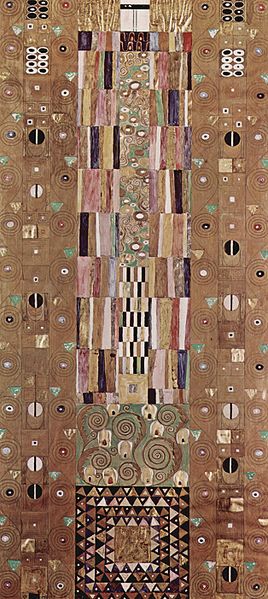Gustav Klimt‘s ‘Golden Phase’ was marked by positive critical reaction and financial success. Many of his paintings from this period include gold leaf. Klimt had previously used gold in his Pallas Athene (1898) and Judith I (1901), although the works most popularly associated with this period are the Portrait of Adele Bloch-Bauer I (1907) and The Kiss (1907–08).
Klimt travelled little, but trips to Venice and Ravenna, both famous for their beautiful mosaics, most likely inspired his gold technique and his Byzantine imagery. In 1904, he collaborated with other artists on the lavish Palais Stoclet, the home of a wealthy Belgian industrialist that was one of the grandest monuments of the Art Nouveau age. Klimt’s contributions to the dining room, including both Fulfillment and Expectation, were some of his finest decorative works, and as he publicly stated, “probably the ultimate stage of my development of ornament.”
The painting is a study for a series of three mosaics created by Klimt for a 1905-1911 commissioned work at the Palais Stoclet in Brussels, Belgium.The mosaics were created in the artist’s Late Works period, and depict swirling Trees of Life, a standing female figure and an embracing couple. The mosaics are spread across three walls of the Palais’ dining room, along with two figural sections set opposite each other.
The mosaics form a part of a larger commission by Belgian financier Adolphe Stoclet and his wife Suzanne. The Stoclets hired architect Josef Hoffmann and the Wiener Werkstätte artistic collective to design, decorate and furnish a spacious mansion with formal gardens. The pair were avid art collectors with wide-ranging and eclectic tastes: their collection included work from a range of periods and cultures, from the Far East to the New World and included Egyptian sculpture, Chinese ceramics and jades, Byzantine icons and jewelry, miniatures from Persia and Armenia, as well as numerous Western mediaeval paintings. The diverse tastes of his patrons corresponded well with Klimt’s own. Art historian M.E. Warlick notes that he “must have been delighted to find that their eclectic collection so matched many of his own recent interests”.
The panels were commissioned and placed along three walls of the Palais’ dining room, with the two larger, figural sections set across from each other along the longer walls of the room. A smaller, geometric panel occupies the short wall separating them. The designs are decorated with a variety of luxury materials, including marble, ceramic, gilded tiles and enamel along with pearls and other semi-precious stones.






